| Rosaceae Temporal range: | |
|---|---|
 | |
| Flower of Rosa pouzinii | |
| Scientific classification | |
| Kingdom: | Plantae |
| Clade: | Tracheophytes |
| Clade: | Angiosperms |
| Clade: | Eudicots |
| Clade: | Rosids |
| Order: | Rosales |
| Family: | Rosaceae Juss. |
| Subfamilies | |
 | |
| Global distribution of Rosaceae | |
| Synonyms[3] | |
Rosaceae (/roʊˈzeɪsiː.iː, -si.aɪ/),[4] the rose family, is a medium-sized family of flowering plants that includes 4,828 known species in 91 genera.[5][6][7]
The name is derived from the type genus Rosa. Among the most species-rich genera are Alchemilla (270), Sorbus (260), Crataegus (260), Cotoneaster (260), Rubus (250),[7] and Prunus (200), which contains the plums, cherries, peaches, apricots, and almonds.[8] However, all of these numbers should be seen as estimates—much taxonomic work remains.
The family Rosaceae includes herbs, shrubs, and trees. Most species are deciduous, but some are evergreen.[9] They have a worldwide range but are most diverse in the Northern Hemisphere.
Many economically important products come from the Rosaceae, including various edible fruits, such as apples, pears, quinces, apricots, plums, cherries, peaches, raspberries, blackberries, loquats, strawberries, rose hips, hawthorns, and almonds. The family also includes popular ornamental trees and shrubs, such as roses, meadowsweets, rowans, firethorns, and photinias.[9]
Description
Rosaceae can be woody trees, shrubs, climbers or herbaceous plants.[10] The herbs are mostly perennials, but some annuals also exist, such as Aphanes arvensis.[11]: 200 [12]
Leaves
The leaves are generally arranged spirally, but have an opposite arrangement in some species. They can be simple or pinnately compound (either odd- or even-pinnate). Compound leaves appear in around 30 genera. The leaf margin is most often serrate. Paired stipules are generally present, and are a primitive feature within the family, independently lost in many groups of Amygdaloideae (previously called Spiraeoideae).[13] The stipules are sometimes adnate (attached surface to surface)[14] to the petiole. Glands or extrafloral nectaries may be present on leaf margins or petioles. Spines may be present on the midrib of leaflets and the rachis of compound leaves.
Flowers
Flowers of plants in the rose family are generally described as "showy".[15] They are radially symmetrical, and almost always hermaphroditic. Rosaceae generally have five sepals, five petals, and many spirally arranged stamens. The bases of the sepals, petals, and stamens are fused together to form a characteristic cup-like structure called a hypanthium. They can be arranged in spikes, or heads. Solitary flowers are rare. Rosaceae have a variety of color petals, but blue is almost completely absent.[10]
Fruits and seeds
The fruits occur in many varieties and were once considered the main characters for the definition of subfamilies amongst Rosaceae, giving rise to a fundamentally artificial subdivision. They can be follicles, capsules, nuts, achenes, drupes (Prunus), and accessory fruits, like the pome of an apple, or the hip of a rose. Many fruits of the family are edible, but their seeds often contain amygdalin, which can release cyanide during digestion if the seed is damaged.[16]
Taxonomy
Taxonomic history
The family was traditionally divided into six subfamilies: Rosoideae, Spiraeoideae, Maloideae (Pomoideae), Amygdaloideae (Prunoideae), Neuradoideae, and Chrysobalanoideae, and most of these were treated as families by various authors.[17][18] More recently (1971), Chrysobalanoideae was placed in Malpighiales in molecular analyses and Neuradoideae has been assigned to Malvales. Schulze-Menz, in Engler's Syllabus edited by Melchior (1964) recognized Rosoideae, Dryadoideae, Lyonothamnoideae, Spireoideae, Amygdaloideae, and Maloideae.[19] They were primarily diagnosed by the structure of the fruits. More recent work has identified that not all of these groups were monophyletic. Hutchinson (1964)[20] and Kalkman (2004) [21] recognized only tribes (17 and 21, respectively). Takhtajan (1997) delimited 21 tribes in 10 subfamilies:[3] Filipenduloideae, Rosoideae, Ruboideae, Potentilloideae, Coleogynoideae, Kerroideae, Amygdaloideae (Prunoideae), Spireoideae, Maloideae (Pyroideae), Dichotomanthoideae. A more modern model comprises three subfamilies, one of which (Rosoideae) has largely remained the same.
While the boundaries of the Rosaceae are not disputed, there is no general agreement as to how many genera it contains. Areas of divergent opinion include the treatment of Potentilla s.l. and Sorbus s.l.. Compounding the problem is that apomixis is common in several genera. This results in an uncertainty in the number of species contained in each of these genera, due to the difficulty of dividing apomictic complexes into species. For example, Cotoneaster contains between 70 and 300 species, Rosa around 100 (including the taxonomically complex dog roses), Sorbus 100 to 200 species, Crataegus between 200 and 1,000, Alchemilla around 300 species, Potentilla roughly 500, and Rubus hundreds, or possibly even thousands of species.
Genera
Identified clades include:
- Subfamily Rosoideae: Traditionally composed of those genera bearing aggregate fruits that are made up of small achenes or drupelets, and often the fleshy part of the fruit (e.g. strawberry) is the receptacle or the stalk bearing the carpels. The circumscription is now narrowed (excluding, for example, the Dryadoideae), but it still remains a diverse group containing five or six tribes and 20 or more genera, including rose, Rubus (blackberry, raspberry), Fragaria (strawberry), Potentilla, and Geum.
- Subfamily Amygdaloideae: Within this group remains an identified clade with a pome fruit, traditionally known as subfamily Maloideae (or Pyroideae) which included genera such as apple, Cotoneaster, and Crataegus (hawthorn). To separate it at the subfamily level would leave the remaining genera as a paraphyletic group, so it has been expanded to include the former Spiraeoideae and Amygdaloideae.[13] The subfamily has sometimes been referred to by the name "Spiraeoideae", but this is not permitted by the International Code of Nomenclature for algae, fungi, and plants.
- Subfamily Dryadoideae: Fruits are achenes with hairy styles, and includes five genera (Dryas, Cercocarpus, Chamaebatia, Cowania, and Purshia), most species of which form root nodules which host nitrogen-fixing bacteria from the genus Frankia.
Phylogeny
The phylogenetic relationships between the three subfamilies within Rosaceae are unresolved. There are three competing hypotheses:
| Amygdaloideae basal | Dryadoideae basal | Rosoideae basal | |||||||||||||||||||||||||||||||||||||||||||||
|---|---|---|---|---|---|---|---|---|---|---|---|---|---|---|---|---|---|---|---|---|---|---|---|---|---|---|---|---|---|---|---|---|---|---|---|---|---|---|---|---|---|---|---|---|---|---|---|
|
|
|
Amygdaloideae basal
Amygdaloideae has been identified as the earliest branching subfamily by Chin et al. (2014),[22] Li et al. (2015),[23] Li et al. (2016),[24] and Sun et al. (2016).[25] Most recently Zhang et al. (2017) recovered these relationships using whole plastid genomes:[26]
| |||||||||||||||||||||||||||||||||||||||||||||||||||||||||||||||||||||||||||||||||||||||||||||||||
The sister relationship between Dryadoideae and Rosoideae is supported by the following shared morphological characters not found in Amygdaloideae: presence of stipules, separation of the hypanthium from the ovary, and the fruits are usually achenes.[26]
Dryadoideae basal
Dryadoideae has been identified as the earliest branching subfamily by Evans et al. (2002)[27] and Potter (2003).[28] Most recently Xiang et al. (2017) recovered these relationships using nuclear transcriptomes:[29]
| |||||||||||||||||||||||||||||||||||||||||||||||||||||||||||||||||||||||||||||||||||||||||||||||||
Rosoideae basal
Rosoideae has been identified as the earliest branching subfamily by Morgan et al. (1994),[30] Evans (1999),[31] Potter et al. (2002),[32] Potter et al. (2007),[13] Töpel et al. (2012),[33] and Chen et al. (2016).[34] The following is taken from Potter et al. (2007):[13]
| |||||||||||||||||||||||||||||||||||||||||||||||||||||||||||||||||||||||||||||||||||||||||||||||||
The sister relationship between Amygdaloideae and Dryadoideae is supported by the following shared biochemical characters not found in Rosoideae: production of cyanogenic glycosides and production of sorbitol.[26]
Distribution and habitat
The Rosaceae have a cosmopolitan distribution, being found nearly everywhere except for Antarctica. They are primarily concentrated in the Northern Hemisphere in regions that are not desert or tropical rainforest.[7]
Uses
The rose family is considered one of the six most economically important crop plant families,[35] and includes apples, pears, quinces, medlars, loquats, almonds, peaches, apricots, plums, cherries, strawberries, blackberries, raspberries, sloes, and roses.
Many genera are also highly valued ornamental plants. These include trees and shrubs (Cotoneaster, Chaenomeles, Crataegus, Dasiphora, Exochorda, Kerria, Photinia, Physocarpus, Prunus, Pyracantha, Rhodotypos, Rosa, Sorbus, Spiraea), herbaceous perennials (Alchemilla, Aruncus, Filipendula, Geum, Potentilla, Sanguisorba), alpine plants (Dryas, Geum, Potentilla) and climbers (Rosa).[9]
However, several genera are also introduced noxious weeds in some parts of the world, costing money to be controlled. These invasive plants can have negative impacts on the diversity of local ecosystems once established. Such naturalised pests include Acaena, Cotoneaster, Crataegus, and Pyracantha.[9]
In Bulgaria and parts of western Asia, the production of rose oil from fresh flowers such as Rosa damascena, Rosa gallica, and other species is an important economic industry.[10]
Gallery
The family Rosaceae covers a wide range of trees, bushes and plants.
 Buzzy burr (Acaena magellanica)
Buzzy burr (Acaena magellanica) Common lady's mantle (Alchemilla vulgaris)
Common lady's mantle (Alchemilla vulgaris) Goat's beard (Aruncus dioicus)
Goat's beard (Aruncus dioicus) Maule's quince (Chaenomeles japonica)
Maule's quince (Chaenomeles japonica)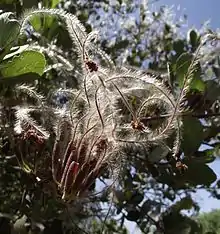 Mountain mahogany (Cercocarpus betuloides)
Mountain mahogany (Cercocarpus betuloides) Northern downy hawthorn (Crataegus submollis)
Northern downy hawthorn (Crataegus submollis) Creeping cotoneaster (Cotoneaster adpressus)
Creeping cotoneaster (Cotoneaster adpressus) Shrubby cinquefoil (Dasiphora fruticosa)
Shrubby cinquefoil (Dasiphora fruticosa)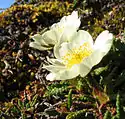 Mountain avens (Dryas octopetala)
Mountain avens (Dryas octopetala) Loquat (Eriobotrya japonica), a fruit tree typical by flowering in autumn
Loquat (Eriobotrya japonica), a fruit tree typical by flowering in autumn Pearlbush (Exochorda racemosa)
Pearlbush (Exochorda racemosa)_Filipendula_vulgaris_-_Inflorescence.jpg.webp) Dropwort (Filipendula vulgaris)
Dropwort (Filipendula vulgaris)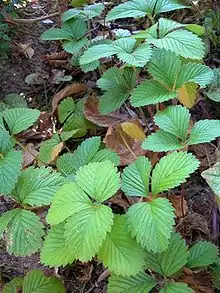 Musk strawberry (Fragaria moschata) valued for its intense aroma
Musk strawberry (Fragaria moschata) valued for its intense aroma Old man's whiskers (Geum triflorum)
Old man's whiskers (Geum triflorum) Kerria japonica
Kerria japonica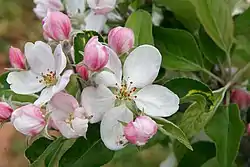 Apple tree blossoms (Malus pumila)
Apple tree blossoms (Malus pumila) Common medlar (Mespilus germanica)
Common medlar (Mespilus germanica)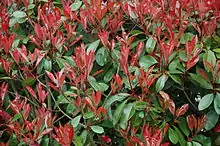 Red Tip Photinia (Photinia x fraseri) popular for red color of its new growths
Red Tip Photinia (Photinia x fraseri) popular for red color of its new growths Common ninebark (Physocarpus opulifolius)
Common ninebark (Physocarpus opulifolius) Creeping cinquefoil (Potentilla reptans)
Creeping cinquefoil (Potentilla reptans)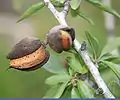 Mature fruit of an almond tree (Prunus dulcis)
Mature fruit of an almond tree (Prunus dulcis).JPG.webp) Blackthorn (Prunus spinosa)
Blackthorn (Prunus spinosa)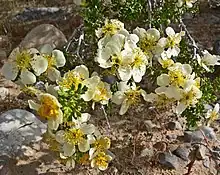 Stansbury's cliffrose (Purshia stansburyana)
Stansbury's cliffrose (Purshia stansburyana) Scarlet firethorn (Pyracantha coccinea)
Scarlet firethorn (Pyracantha coccinea)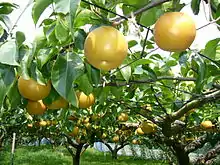 Nashi pear (Pyrus pyrifolia) typical for Asian countries
Nashi pear (Pyrus pyrifolia) typical for Asian countries Rhodotypos scandens, a Japanese shrub with fruits high in toxic amygdalin
Rhodotypos scandens, a Japanese shrub with fruits high in toxic amygdalin The silky rose (Rosa sericea) known for its ornamental prickles
The silky rose (Rosa sericea) known for its ornamental prickles Salmonberry (Rubus spectabilis)
Salmonberry (Rubus spectabilis) Great burnet (Sanguisorba officinalis)
Great burnet (Sanguisorba officinalis) Autumn foliage of the Korean mountain ash (Sorbus alnifolia)
Autumn foliage of the Korean mountain ash (Sorbus alnifolia) Rose meadowsweet (Spiraea splendens)
Rose meadowsweet (Spiraea splendens) Rosa chinensis
Rosa chinensis
References
- ↑ Zhang S.-D.; Jin J.-J.; Chen S.-Y.; et al. (2017). "Diversification of Rosaceae since the Late Cretaceous based on plastid phylogenomics". New Phytol. 214 (3): 1355–1367. doi:10.1111/nph.14461. PMID 28186635.
- ↑ "Rosales". www.mobot.org. Retrieved 16 June 2023.
- 1 2 Takhtajan A. (1997). Diversity and Classification of Flowering Plants. New York: Columbia University Press. pp. 1–620. ISBN 978-0-231-10098-4.
- ↑ "Rosaceae". Merriam-Webster.com Dictionary.
- ↑ "The Plant List: Rosaceae". Royal Botanic Gardens, Kew and Missouri Botanic Garden. Retrieved 20 November 2016.
- ↑ Christenhusz, M. J. M. & Byng, J. W. (2016). "The number of known plants species in the world and its annual increase". Phytotaxa. 261 (3): 201–217. doi:10.11646/phytotaxa.261.3.1.
- 1 2 3 "Angiosperm Phylogeny Website". mobot.org.
- ↑ Bortiri, E.; Oh, S.-H.; Jiang, J.; Baggett, S.; Granger, A.; Weeks, C.; Buckingham, M.; Potter, D.; Parfitt, D.E. (2001). "Phylogeny and Systematics of Prunus (Rosaceae) as Determined by Sequence Analysis of ITS and the Chloroplast trnL–trnF Spacer DNA". Systematic Botany. 26 (4): 797–807. doi:10.1043/0363-6445-26.4.797 (inactive 1 August 2023). JSTOR 3093861.
{{cite journal}}: CS1 maint: DOI inactive as of August 2023 (link) - 1 2 3 4 Watson, L.; Dallwitz, M.J. (1992). "The families of flowering plants: Rosaceae L." Description Language for Taxonomy. Archived from the original on 14 May 2011. Retrieved 21 April 2010.
- 1 2 3 Heywood, V.H.; Brummitt, R.K.; Culham, A.; Seberg, O. (2007). Flowering Plant Families of the World. Ontario, Canada: Firefly Books. pp. 280–282. ISBN 978-1-55407-206-4.
- ↑ Stace, C. A. (2019). New Flora of the British Isles (Fourth ed.). Middlewood Green, Suffolk, U.K.: C & M Floristics. ISBN 978-1-5272-2630-2.
- ↑ "Rosaceae Juss.: FloraBase: Flora of Western Australia". calm.wa.gov.au. Archived from the original on 15 March 2011. Retrieved 21 April 2010.
- 1 2 3 4 Potter D, Eriksson T, Evans RC, Oh S, Smedmark JE, Morgan DR, Kerr M, Robertson KR, Arsenault M, Dickinson TA, Campbell CS (2007). "Phylogeny and classification of Rosaceae" (PDF). Plant Systematics and Evolution. 266 (1–2): 5–43. doi:10.1007/s00606-007-0539-9. JSTOR 23655774. S2CID 16578516.
- ↑ Beentje, H. (2010). The Kew Plant Glossary, an Illustrated Dictionary of Plant Terms. Kew, London, U.K.: Kew publishing. ISBN 978-1-842-46422-9.
- ↑ Folta, Kevin M.; Gardiner, Susan E., eds. (2008). Genetics and Genomics of Rosaceae (1 ed.). New York: Springer. p. 2. ISBN 978-0-387-77490-9.
- ↑ TOXNET: CASRN: 29883-15-6
- ↑ Caratini, Roger. La Vie de plantes. 1971. Encyclopédie Bordas.
- ↑ Lawrence, G.H.M. 1960. Taxonomy of Vascular Plants. Macmillan.
- ↑ Schulze-Menz GK. (1964). "Rosaceae". In Melchior H (ed.). Engler's Syllabus der Pflanzenfamilien. Vol. II (12 ed.). Berlin: Gebrüder Borntraeger. pp. 209–218.
- ↑ Hutchinson J. (1964). The Genera of Flowering Plants. Vol. 1, Dicotyledons. Oxford: Clarendon Press. pp. 1–516.
- ↑ Kalkman C. (2004). "Rosaceae". In Kubitzki K (ed.). Flowering plants—Dicotyledons: Celastrales, Oxalidales, Rosales, Cornales, Ericales. The Families and Genera of Vascular Plants. Vol. 6 (1 ed.). Berlin Heidelberg: Springer-Verlag. pp. 343–386. doi:10.1007/978-3-662-07257-8. ISBN 978-3-540-06512-8. S2CID 12809916.
- ↑ Chin SW, Shaw J, Haberle R, Wen J, Potter D (2014). "Diversification of almonds, peaches, plums and cherries—Molecular systematics and biogeographic history of Prunus (Rosaceae)". Mol Phylogenet Evol. 76: 34–48. doi:10.1016/j.ympev.2014.02.024. PMID 24631854.
- ↑ Li HL, Wang W, Mortimer PE, Li RQ, Li DZ, Hyde KD, Xu JC, Soltis DE, Chen ZD (2015). "Large-scale phylogenetic analyses reveal multiple gains of actinorhizal nitrogen-fixing symbioses in angiosperms associated with climate change". Sci Rep. 5: 14023. Bibcode:2015NatSR...514023L. doi:10.1038/srep14023. PMC 4650596. PMID 26354898.
- ↑ Li HL, Wang W, Li RQ, Zhang JB, Sun M, Naeem R, Su JX, Xiang XG, Mortimer PE, Li DZ, Hyde KD, Xu JC, Soltis DE, Soltis PS, Li J, Zhang SZ, Wu H, Chen ZD, Lu AM (2016). "Global versus Chinese perspectives on the phylogeny of the N-fixing clade". Journal of Systematics and Evolution. 54 (4): 392–399. doi:10.1111/jse.12201. S2CID 88546939.
- ↑ Sun Miao; Naeem Rehan; Su Jun-Xia; Cao Zhi-Yong; Burleigh J. Gordon; Soltis Pamela S.; Soltis Douglas E.; Chen Zhi-Duan (2016). "Phylogeny of the Rosidae: A dense taxon sampling analysis". Journal of Systematics and Evolution. 54 (4): 363–391. doi:10.1111/jse.12211.
- 1 2 3 Zhang SD, Jin JJ, Chen SY, Chase MW, Soltis DE, Li HT, Yang JB, Li DZ, Yi TS (2017). "Diversification of Rosaceae since the Late Cretaceous based on plastid phylogenomics". New Phytol. 214 (3): 1355–1367. doi:10.1111/nph.14461. PMID 28186635.
- ↑ Evans RC, Campbell C, Potter D, Morgan D, Eriksson T, Alice L, Oh SH, Bortiri E, Gao F, Smedmark J, Arsenault M (2–7 August 2002). "A Rosaceae phylogeny". Abstracts. Botany 2002—Botany in the Curriculum: Integrating Research and Teaching. Madison, Wisconsin: Botanical Society of America, St. Louis. p. 108.
- ↑ Potter D. (2003). "Molecular phylogenetic studies in Rosaceae". In Sharma AK, Sharma A (eds.). Plant Genome: Biodiversity and Evolution. Vol. 1, Part A: Phanerogams. Enfield, NH: Scientific Publications. pp. 319–351. ISBN 978-1-578-08238-4.
- ↑ Xiang Y, Huang CH, Hu Y, Wen J, Li S, Yi T, Chen H, Xiang J, Ma H (2017). "Evolution of Rosaceae fruit types based on nuclear phylogeny in the context of geological times and genome duplication". Mol Biol Evol. 34 (2): 262–281. doi:10.1093/molbev/msw242. PMC 5400374. PMID 27856652.
- ↑ Morgan DR, Soltis DE, Robertson KR (1994). "Systematic and evolutionary implications of rbcL sequence variation in Rosaceae". Am J Bot. 81 (7): 890–903. doi:10.2307/2445770. JSTOR 2445770.
- ↑ Evans R. (1999). "Rosaceae Phylogeny: Origin of Subfamily Maloideae". Rosaceae Phylogeny and Evolution. Botany Department, University of Toronto. Retrieved 7 July 2017.
- ↑ Potter D, Gao F, Esteban Bortiri P, Oh SH, Baggett S (2002). "Phylogenetic relationships in Rosaceae inferred from chloroplast matK and trnL–trnF nucleotide sequence data". Plant Syst Evol. 231 (1–4): 77–89. doi:10.1007/s006060200012. S2CID 35829880.
- ↑ Töpel M, Antonelli A, Yesson C, Eriksen B (2012). "Past climate change and plant evolution in Western North America: A case study in Rosaceae". PLOS One. 7 (12): e50358. Bibcode:2012PLoSO...750358T. doi:10.1371/journal.pone.0050358. PMC 3517582. PMID 23236369.
- ↑ Chen ZD, Yan T, Lin L, Lu LM, Li HL, Sun M, Liu B, Chen M, Niu YT, Ye JF, Cao ZY, Liu HM, Wang XM, Wang W, Zhang JB, Meng Z, Cao W, Li JH, Wu SD, Zhao HL, Liu ZJ, Du ZY, Wan QF, Guo J, Tan XX, Su JX, Zhang LJ, Yang LL, Liao YY, Li MH, Zhang GQ, Chung SW, Zhang J, Xiang KL, Li RQ, Soltis DE, Soltis PS, Zhou SL, Ran JH, Wang XQ, Jin XH, Chen YS, Gao TG, Li JH, Zhang SZ, Lu AM, et al. (China Phylogeny Consortium) (2016). "Tree of life for the genera of Chinese vascular plants". Journal of Systematics and Evolution. 54 (4): 277–306. doi:10.1111/jse.12219.
- ↑ B.C. Bennett (undated). Economic Botany: Twenty-Five Economically Important Plant Families. Encyclopedia of Life Support Systems (EOLSS) e-book
External links
- Rosaceae at the DELTA Online Families of Flowering Plants Archived 14 May 2011 at the Wayback Machine